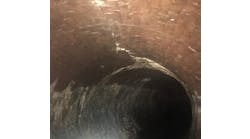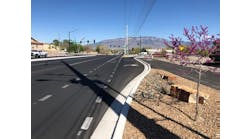With civil penalties as high as $27,500 per violation per day and possible criminal prosecution, there are several things about the federal Clean Water Act (CWA) that transportation contractors need to know.
Signed into law on Oct. 18, 1972, in response to public outrage over the Cuyahoga River fire in Cleveland, the CWA continues to evolve as the U.S. Environmental Protection Agency (EPA) and the U.S. Army Corps of Engineers add new regulations and mandates under the law.
In fact, the CWA is one of the largest contributors to the explosion of federal regulation that has occurred in the environmental arena over the past 30 years. In 1970, almost no federal environmental regulations existed. By 1990, there were almost 11,000 pages of federal environmental regulations. Today, there are almost 20,000 pages and growing. To the unwary contractor, these regulations can result in hundreds of thousands of dollars in fines almost overnight and maybe even jail time.
Besides imposing some very specific requirements on contractors, the CWA also has been the largest obstacle in delaying transportation improvement projects in past years. In a survey of state departments of transportation (DOTs) conducted by the American Road & Transportation Builders Association (ARTBA), almost 400 highway projects worth $2.7 billion were canceled or delayed nationwide in 2000 because of issues raised under the CWA. When asked what was the biggest problem they faced in the environmental review process in order to deliver projects on time, the majority of state DOTs identified the CWA.
Wetland regulations
Perhaps the issue most contractors associate with the CWA is its regulation over wetlands. Under section 404 of the CWA, the Corps--with the advice and consent of the EPA--is empowered to issue permits "for the discharge of dredged or fill material into the navigable waters" of the U.S. However, the precise definition of these terms has resulted in years of litigation and inconsistent enforcement between different Corps districts.
Historically, the Corps and the EPA have interpreted "navigable waters" very broadly to include even the smallest wetland or even streams that only run intermittently when it rains. The agencies' justification for doing so was the so-called "migratory bird rule," which stated that waterfowl use these small waters, attracting bird watchers and hunters. Since the bird watchers might travel across state lines to see the birds and hunters buy shotgun shells that travel across state lines, even these small waters affect interstate commerce, thereby making them navigable. Needless to say, this seems to be a stretch of the definition on its very face. As a result, industry and local governments challenged the rule in court and it was struck down in 2001 by the U.S. Supreme Court.
However, despite the Supreme Court's ruling, the Corps and the EPA have continued to try to regulate even the smallest wetlands. They stated that other laws gave them authority to do so and also advanced the theory--which many have nicknamed the "migratory molecule theory"--that these small bodies of water are "hydrologically connected" to larger navigable waters. Finally, on Jan. 15, 2003, under great pressure from industry, the agencies issued guidance instructing their field offices to stop regulating isolated wetlands unless they first receive prior approval from headquarters. According to the EPA, this will reduce the number of wetlands they can regulate by about 20%. The agencies also announced they would undertake an official rulemaking to better define what can be regulated under the CWA and what cannot.
The Corps and the EPA have taken an equally broad interpretation of the second part of section 404 of the CWA of what constitutes a "discharge of dredged or fill material." On its face, it would appear the CWA only permits the regulation of placing materials into a body of water, not taking material out. However, in the so-called "Tulloch rule," the agencies argued that when you remove dirt from water, small particles fall off the bucket back into the water. As a result, according to the federal government, when you are taking material out, you also are placing material in the water, thereby allowing the Corps and the EPA to regulate the activity. Once again, ARTBA and other industry groups challenged this broad interpretation of the CWA in the courts and prevailed. The court said the CWA does not allow for the regulation of mere incidental fallback. And, once again, the Corps and the EPA have repeatedly tried to circumvent the court's decision.
The current rule states that unless a contractor can prove otherwise, it is presumed that more than just incidental fallback is falling into the water when material is being removed. ARTBA and other industry groups are currently challenging this rule in the courts. It was thought that the Supreme Court would help settle this long-standing dispute between the agencies and industry in a case before it in its current term. However, that case was dismissed in December in a split 4-4 decision by the court where Justice Kennedy abstained because he knew one of the litigants. As a result, the case that ARTBA is involved in has been expedited and will be heard by the courts soon.
Storm water permitting
Another part of the CWA that has a very direct impact on contractors on a day-to-day basis is the storm water permitting requirement. In 1987, the CWA was amended to include the National Pollution Discharge Elimination System, which led the EPA to establish regulations in 1990 to control storm water runoff from construction sites. The EPA has delegated authority to all but seven states to perform their own permitting and enforcement in this area, but all of the state programs must be consistent with the EPA's mandates.
Under Phase I of the rules, any construction site that disturbs five or more acres of land must obtain a permit if the site will discharge runoff into a "water of the United States." This includes the contractor, who has day-to-day control over the site, as well as the developer, who has control over the specifications and plans for the project. To meet this requirement, the EPA established the Construction General Permit (CGP) and states that run their own programs have established very similar permits. Under the EPA's CGP a contractor is required to file a Notice of Intent two days prior to starting work on a project. Soil stabilization must take place within 14 days after the last work on the project, and a Notice of Termination must be filed within 30 days. If the project involves special circumstances such as endangered species, historic preservation or impaired waters, the contractor may have to apply for an individual permit, which is a much more complicated process.
As part of the permit, a Storm Water Pollution Prevention Plan must be established, which includes a description of the site and possible sources of pollution and watershed affected, best management practices that will be used to control runoff and who is responsible for implementing them, a schedule for inspection, provisions for maintaining all of the control and a site map and sequence of construction. Beginning March 10, 2003, the EPA was scheduled to start enforcing Phase II of the storm water rules, which will apply these same requirements to smaller construction sites of one acre or more.
Effluent limitation guidelines
If all of this doesn't seem like enough regulation already, the EPA is currently under a court order to establish new effluent guidelines for the construction industry by March 2004. Effluent guidelines are national technology-based standards established for specific industries to control the discharge of pollution into waterways. For the construction industry, this would include runoff from construction sites during land disturbances and the design, installation and maintenance of permanent erosion and sediment controls for a project or development.
Before drafting the proposed rule, the EPA was required to convene a panel of small-business representatives affected by it and to mitigate any adverse effects on small businesses. This panel, which included three ARTBA representatives, convinced the EPA to abandon its most costly proposal, which would have mandated specific technologies or numerical reductions that required constant on-site testing of sediment runoff, computer modeling, etc. On June 24, 2002, the EPA set forth three possible options for the new regulation: (1) do nothing but continue to enforce Phase I and Phase II of the storm water requirements, (2) establish minimum requirements for inspection and certification of work sites or (3) require inspection and certification and require state programs to follow the existing requirements under the EPA's CGP. ARTBA and most industry groups continue to back option one. Environmental groups have threatened to challenge the EPA in court if it is not more aggressive in establishing its final guidelines.
The CWA and other federal laws provide a myriad of obstacles for contractors performing their day-to-day business. By being involved in groups like ARTBA, contractors can stay informed and help mold these regulations as they develop, hopefully reducing burdensome compliance costs for the industry while also improving the environment.


